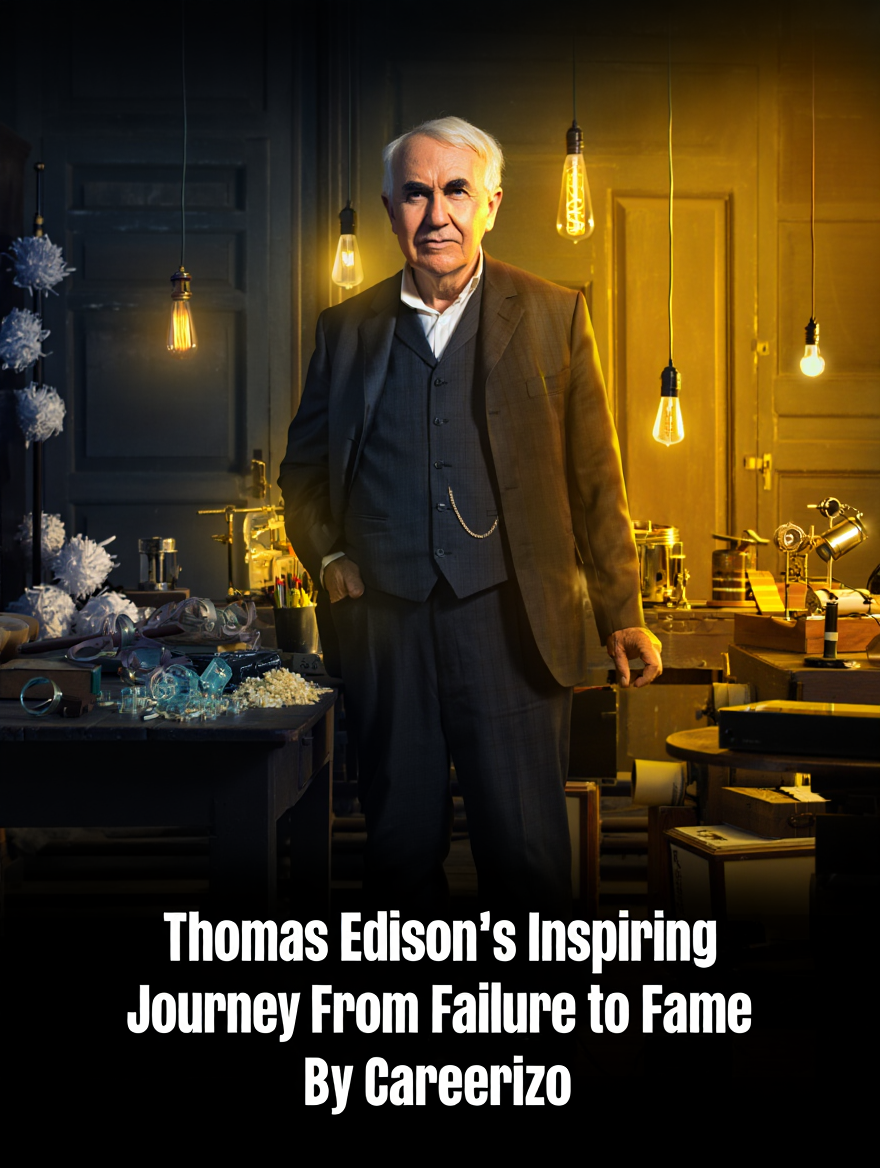Thomas Edison’s Inspiring Journey: From Failure to Fame By Careerizo
Did you know Thomas Edison did more than 1,000 tests before he made the light bulb work? This amazing bit of info shows how tough and firm he was. His long search shows us how not giving up, even when it’s hard, can bring big changes.
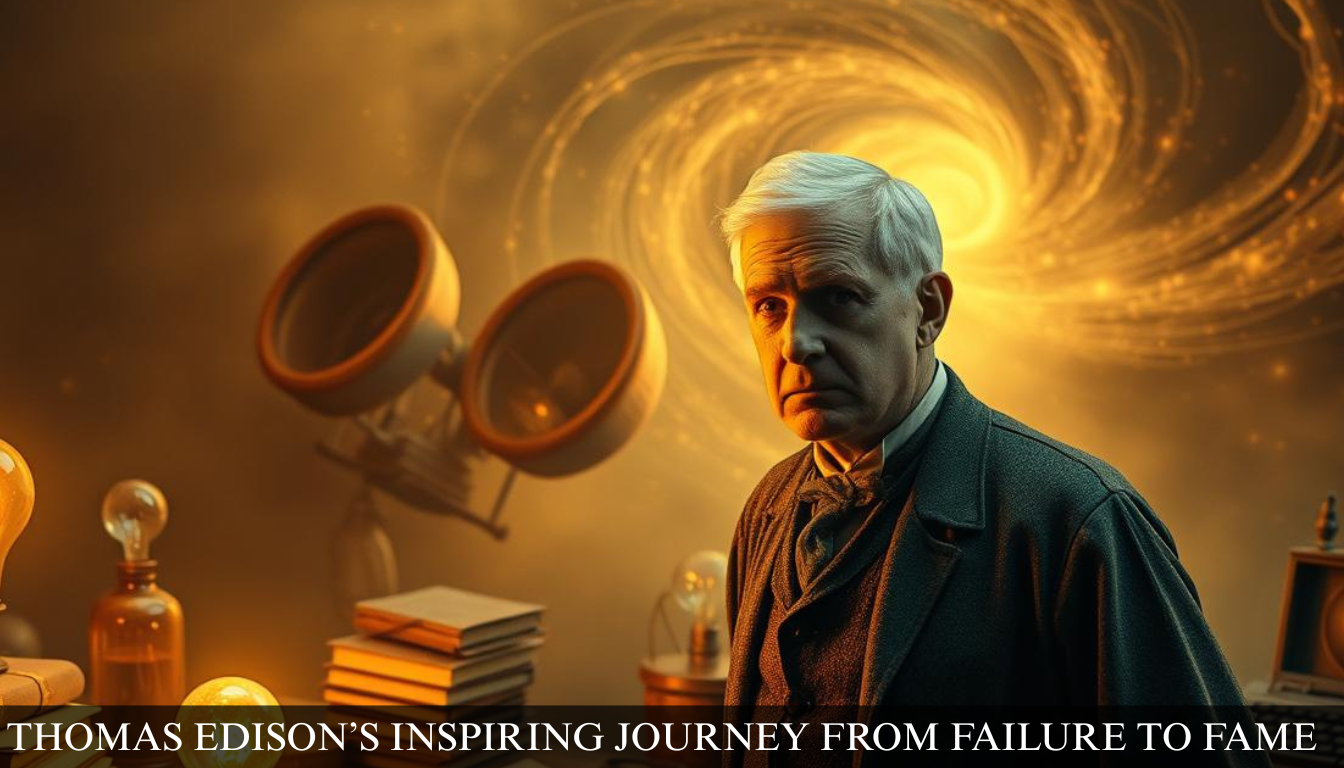
Edison’s story is not just about his inventions; it’s about his relentless pursuit of innovation. Despite facing numerous failures, he continued to push boundaries, ultimately transforming the world with his groundbreaking discoveries.
Key Takeaways
- The significance of perseverance in overcoming obstacles.
- Edison’s approach to experimentation and innovation.
- The impact of his inventions on modern society.
- Lessons learned from Edison’s journey to success.
- The role of resilience in achieving fame.
The Early Years of Thomas Edison
Thomas Edison’s journey to becoming one of the most prolific inventors in history began in Milan, Ohio. Born on February 11, 1847, Edison’s early life was characterized by a curious nature and a series of experiences that would later influence his inventions.
Birth and Childhood in Milan, Ohio
Edison came into this world in Milan, Ohio to Samuel and Nancy Edison. His family resided in Milan, and then later Port Huron, Michigan, where the moved when he was seven. A mix of science and mechanics was always present in Edison’s childhood, and he actively partook in different experiments.
Hearing Loss and Its Impact on His Development
At a young age, Edison suffered from hearing loss, which is believed to have been caused by scarlet fever and recurring ear infections. This condition had a significant impact on his development, making him more introverted and focused on his internal world.
Self-Education After Only Three Months of Formal Schooling
Milan, Ohio, Samuel and Nancy Edison’s home at which Edison was born He grew up in Milan, and then he moved to Port Huron, Michigan when his family relocated to the U.S. when he was seven. Born on February 11th, 1847 in Milan, Ohio Edison’s formative years were characterised by a penchant for science and mechanics, he dabbled in experiments here and there. The widespread belief that he was ‘addled’ by his teacher and his failure to listen in school meant that Edison had only three months of formal education. His mom, Nancy, still home-schooled him so that he could grow his love of books and experiments. A thirst for knowledge made Edison an inventor.
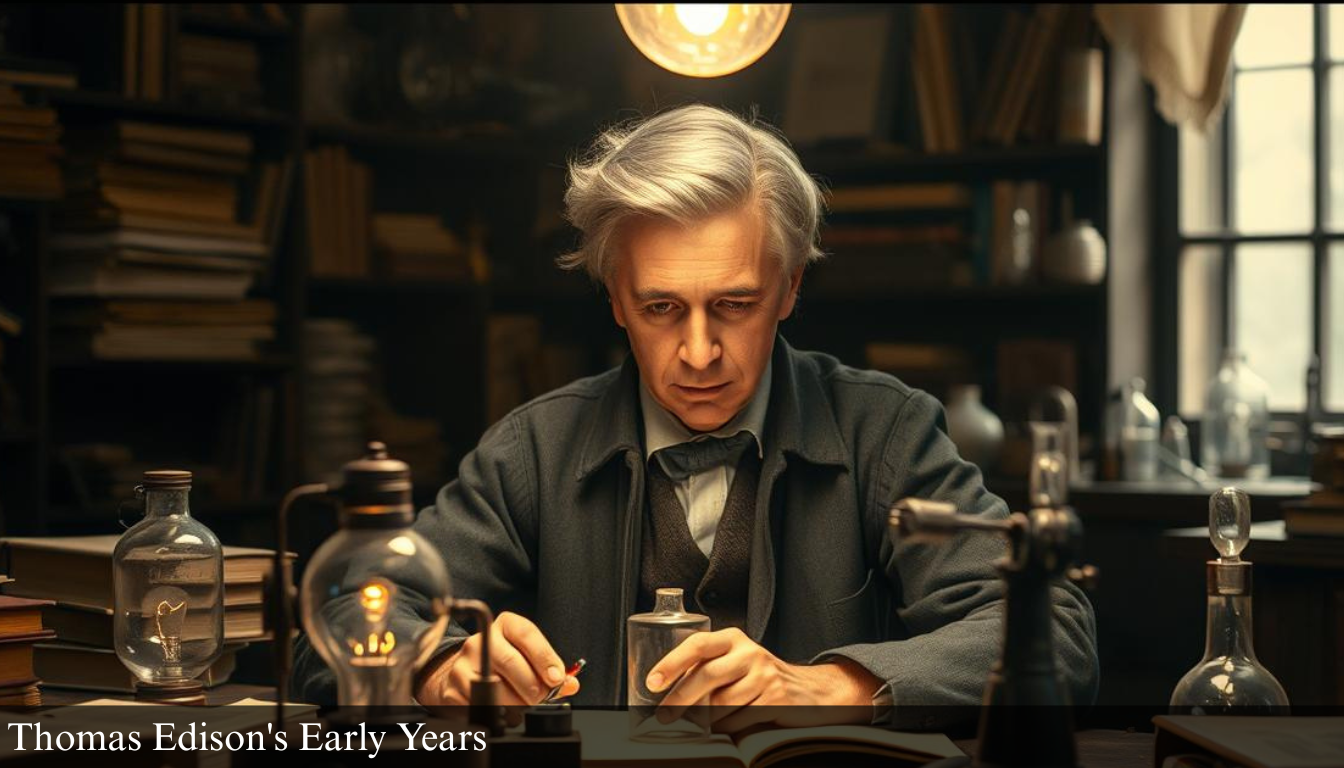
These formative experiences not only molded the lad, but also marked the foundation of his career as one of the famous inventors of all time. It is during these times, in his formative years, that he learned to be resilient and how to overcome adversity.
First Entrepreneurial Ventures and Failures
The young Edison embarked on various entrepreneurial ventures, many of which ended in disappointment. These early experiences, though marked by failures, played a crucial role in shaping his future successes.
The Grand Trunk Herald: Publishing a Newspaper on a Train
The Grand Trunk Herald, a newspaper published on the Grand Trunk Railway train, was one of Edison’s first commercial endeavors. Edison’s early interest in business and invention was demonstrated by this venture. It wasn’t without difficulties, though.
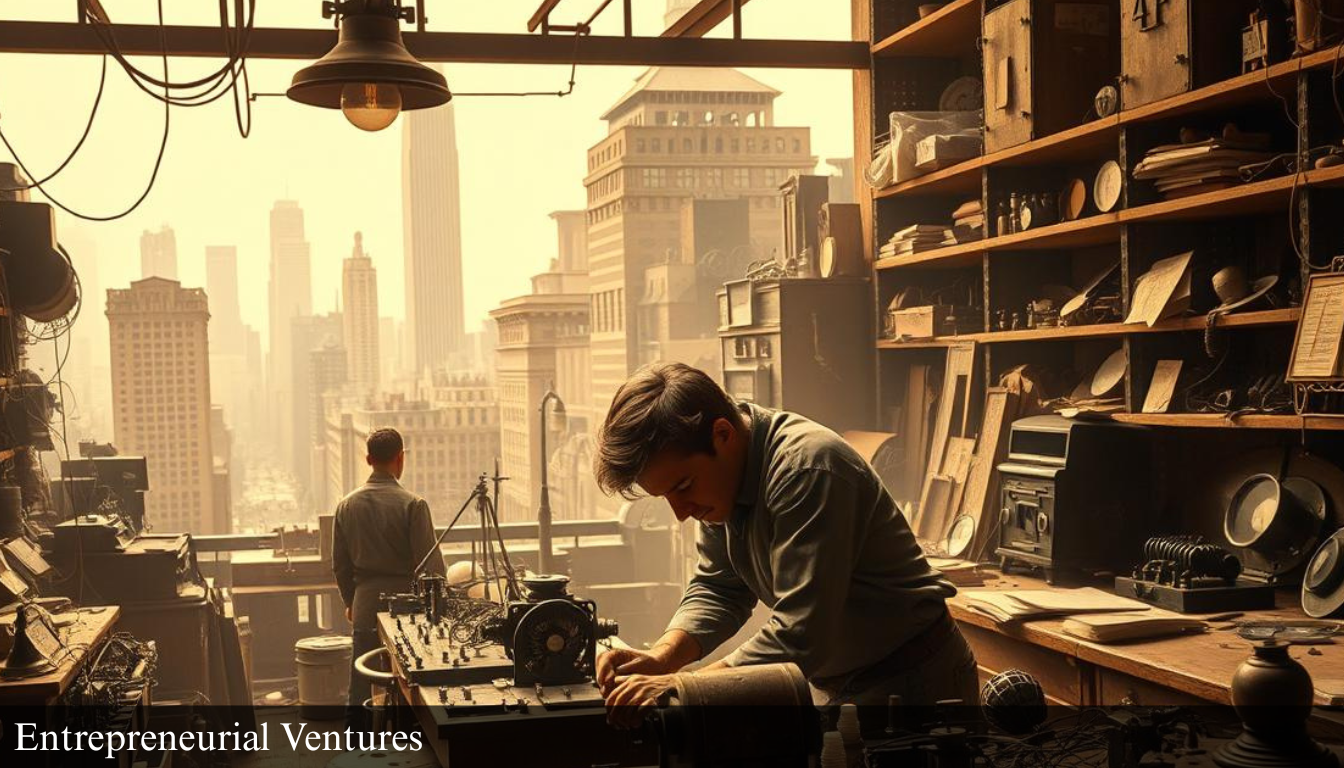
Chemical Experiments Gone Wrong
Edison’s fascination with chemical experiments often led to unexpected outcomes. On one occasion, his experiments resulted in a fire that damaged the train, highlighting the risks associated with his early scientific pursuits.
Fired from Telegraph Jobs
Edison’s experiences working in telegraph jobs were also marked by challenges. He was fired from several positions due to his inability to follow instructions and his tendency to experiment with equipment, demonstrating the difficulties he faced in traditional employment.
These early failures in Edison’s entrepreneurial ventures laid the groundwork for his future achievements. They taught him valuable lessons about perseverance and innovation, ultimately contributing to his success as a renowned inventor.
Edison’s Early Inventions and Disappointments
Edison’s journey as an inventor began with a series of early inventions that were met with both success and failure. His early work was characterized by a willingness to experiment and innovate, often leading to valuable lessons even when his inventions did not achieve immediate success.
The Electric Vote Recorder: A Commercial Failure
One of Edison’s first inventions was the electric vote recorder, designed to quickly record votes in legislative bodies. Despite its innovative technology, the invention failed to gain commercial traction due to a lack of demand from politicians who preferred the traditional method of voting.
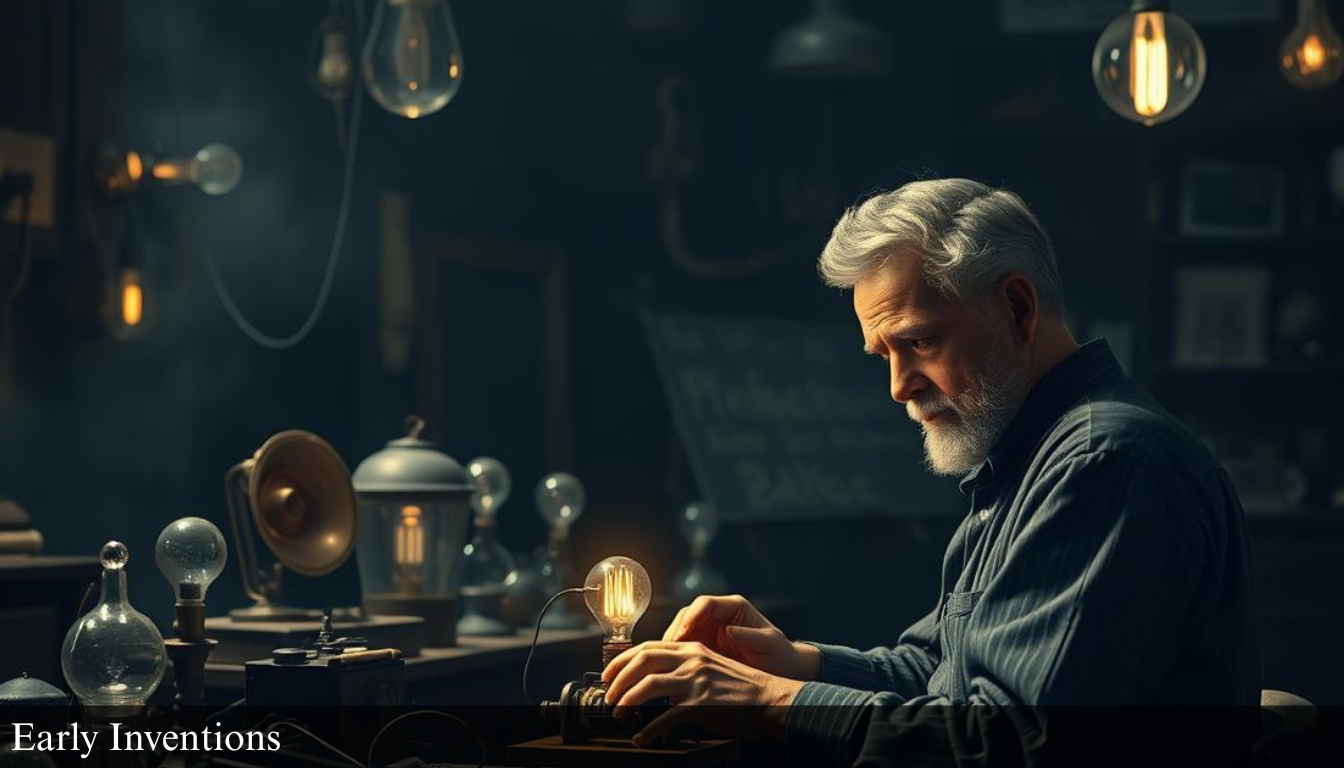
Stock Ticker Improvements: First Financial Success
In contrast to the electric vote recorder, Edison’s improvements to the stock ticker machine were met with significant financial success. His enhanced design allowed for faster and more accurate transmission of stock prices, earning him his first substantial income as an inventor.
Learning from Rejected Ideas
Edison learned valuable lessons from his early inventions, including the electric vote recorder. He understood that not every invention would be a commercial success, but each failure provided insight into what worked and what didn’t, guiding his future inventive endeavors.
By embracing both the successes and failures of his early inventions, Edison laid the groundwork for his later achievements, demonstrating the importance of perseverance and continuous innovation in the face of disappointment.
The Mindset That Transformed Failure Into Opportunity
Thomas Edison’s success story is often attributed to his extraordinary mindset, which allowed him to turn failures into stepping stones. His approach to innovation and perseverance is a valuable lesson for anyone facing setbacks in their endeavors.
One of the major ideas communicated in Edison’s phrase, “I (Edison) haven’t failed at all. Instead, I have found at least 10,000 ways not to succeed,” is the attitude of the inventor towards failure. It is not just about the glass half full; it is a practical position that, through mistakes, puts focus on learning.
“I Have Not Failed. I’ve Just Found 10,000 Ways That Won’t Work”
This quote highlights Edison’s resilience and his ability to view failure as a necessary step towards success. It demonstrates how he maintained a positive outlook even in the face of repeated setbacks.
Edison’s Unique Approach to Experimentation
method of experimenting was really quite methodical and extensive. He was convinced that in order to find a solution one should try out different hypotheses, in short – he believed in rigorous testing. One of the most famous cases where his methodological approach was visible is probably the invention of the light bulb in which he went through a vast array of materials until he found the right
Developing Resilience Through Repeated Setbacks
Through numerous and diverse challenges, Edison constructed his resilience. His capacity to recover from the failure was very important in his way to success. This resilience was more than just a characteristic of the individual but also an outcome of his methodical approach to troubleshooting.
"Our greatest weakness lies in giving up. The most certain way to succeed is always to try just one more time."
This quote further emphasizes Edison’s belief in persistence as a key to success. His mindset and approach to experimentation continue to inspire innovators and entrepreneurs today.
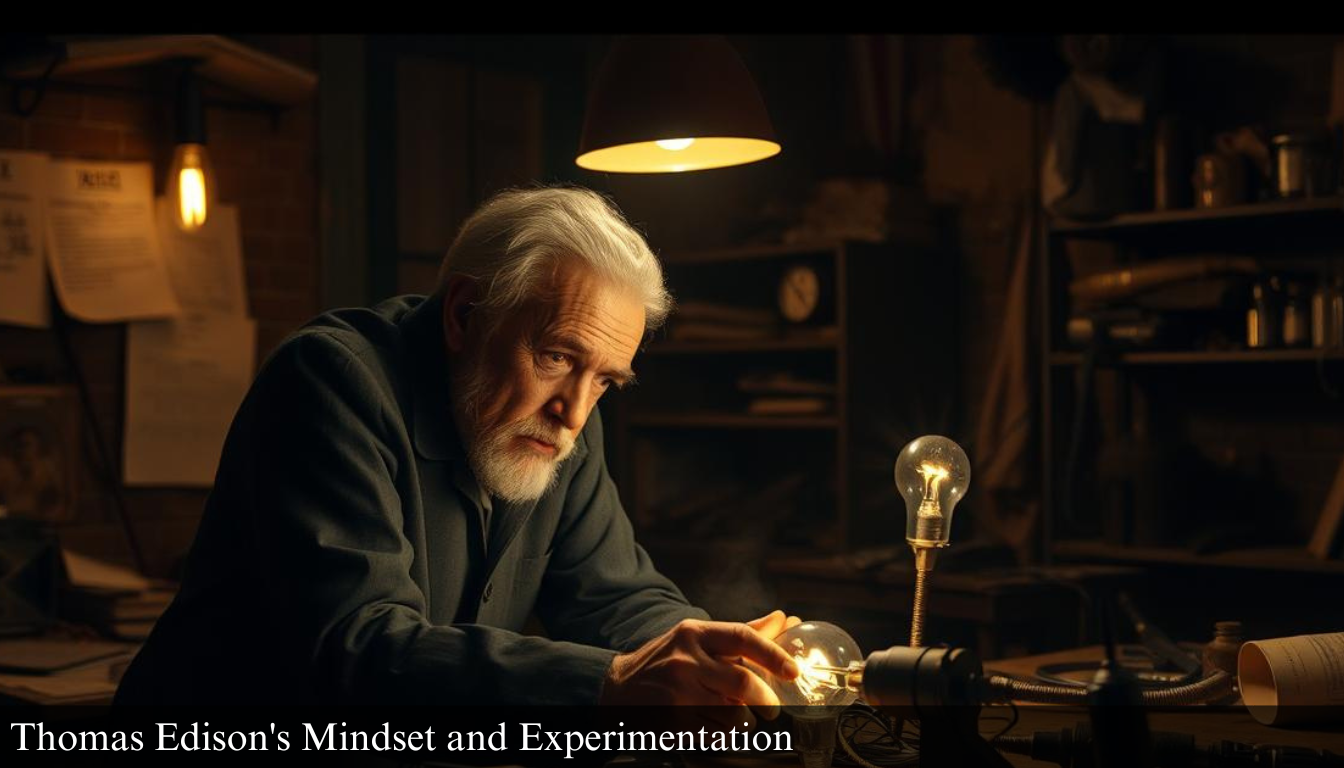
Breakthrough: The Phonograph and Rise to Fame
Edison’s accidental discovery of sound recording led to the creation of the phonograph, a breakthrough that earned him widespread recognition. While working on improvements to the telegraph, Edison discovered that his machine could record and play back sound.
The Accidental Discovery of Sound Recording
The phonograph was invented in 1877, and it was a device that could capture and play back sound using a cylinder covered in tinfoil. Edison’s experimentation with the telegraph led to the realization that his machine could record the sound of the human voice.
Key features of the phonograph included:
- Cylinders wrapped in tinfoil for recording
- A diaphragm that vibrated with sound waves
- A stylus that etched the vibrations onto the cylinder
Public Demonstrations and Instant Celebrity Status
Phonograph was introduced for the first time to the public on November 29, 1877, at Menlo Park. With the device attracting the attention of both the press and the public, the demonstration made a big success. It was Edison’s creation that made him quickly famous and known as “The Wizard of Menlo Park”.
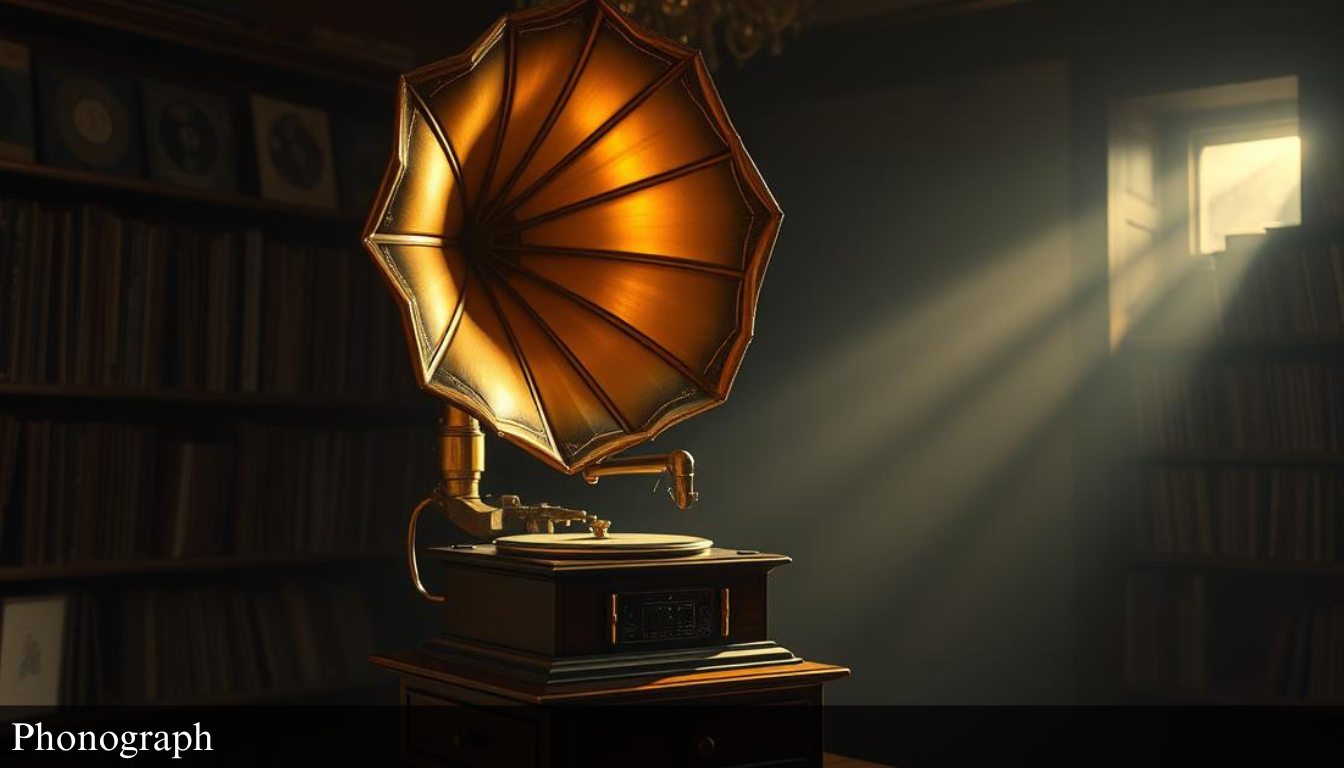
From Unknown Inventor to “The Wizard of Menlo Park”
Edison’s popularity grew quickly and deeply. Not just that the phonograph brought him money but it also made him one of the most prominent scientists. His fame made him accessible to new projects and partnerships which were contributing to his continued success as a trailblazing inventor.
The phonograph’s impact on Edison’s career was significant, marking a turning point in his journey to becoming one of the most renowned inventors in history.
Thomas Edison’s Inspiring Journey From Failure to Fame By Careerizo
From numerous setbacks to unparalleled success, Thomas Edison’s inspiring journey is a tale of transformation. Edison’s life is a testament to the power of perseverance, demonstrating how one can turn failures into stepping stones for success.
Transforming Disappointments into Stepping Stones
Thomas Edison’s perspective on failure was really creatively the same as his inventions. To him, each failure was not an end but an opportunity to learn more and develop new skills. This type of thinking not only made him stick during the tough times but also enabled him to make significant inventions.
The Pattern of Persistence in Edison’s Career
Edison was consistent with his career non-stop. For one thing he did not only repeat all his experiments and tests but also launched new products even if he met a lot of difficulties. By his constant push for perfection, he made a lot of contributions to different fields which acknowledged his innovation process.
How Initial Failures Shaped His Greatest Successes
At the start of Edison’s working life, he encountered setbacks which in turn significantly influenced the manner in which he later achieved success. Practically, each one of the mishaps he learned a lot of things and that was what led him to the innovations most people associate with, such as the phonogram and the light bulb. One of the ways in which Edison was known is that after he had identified the cause of the failure, he was always very self-critical and then, he would apply the same lessons to other works which, in a way, contributed to his global recognition.
In conclusion, Edison’s journey from failure to fame was marked by his persistence and ability to transform disappointments into stepping stones. His story serves as an inspiration to anyone facing obstacles on their path to success.
The Light Bulb: 1,000 Failures Before Success
Edison’s work on the light bulb exemplifies his approach to innovation, where failure was an integral part of the journey to success. The development of the light bulb was a complex process that involved extensive experimentation and perseverance.
The Exhaustive Search for the Perfect Filament
Edison’s search single-handed for the right filament was a story of multiple tries and technical mishaps. Among the different materials he experimented with were carbon filaments. The exploration was long and the inventor and his group putting in endless hours to find out which one would be the best material.
Failed Experiments and Materials That Didn’t Work
Edison’s crew stayed dedicated to their objectives despite the several setbacks. They noted every failure and then used the data to improve their strategy. Among the tested materials were:
- Carbon filaments
- Various metals
- Different bamboo species
The Carbonized Bamboo Breakthrough
Carbonized bamboo’s use was the innovation. It was discovered that this substance was essential to creating a light bulb with a longer lifespan. The filament that Edison’s team created burned for numerous hours at a relatively modest voltage.
Creating an Entire Electrical System, Not Just a Bulb
The light bulb itself was not the only invention made by Edison. He understood that a complete electrical system with distribution networks, transmission lines, and generators was required. The broad use of electric illumination was made possible by this all-encompassing strategy.
The development of the light bulb is a testament to Edison’s innovative spirit and his ability to turn failure into success. His work in this area paved the way for the modern electrical grid and had a profound impact on society.
Building an Innovation Empire from Setbacks
With the establishment of Menlo Park in 1876, Edison took a significant step towards creating an innovation empire. Menlo Park, the world’s first industrial research laboratory, was a groundbreaking facility that allowed Edison to systematically develop and test his inventions.
Menlo Park: The World’s First Industrial Research Laboratory
Menlo Park was more than just a laboratory; it was a hub of innovation where Edison and his team worked tirelessly to bring new ideas to life. The facility was equipped with state-of-the-art equipment and staffed by a talented team of engineers and technicians.
Edison General Electric and the Business of Innovation
The success of Edison’s inventions led to the establishment of Edison General Electric, a company that would play a crucial role in the commercialization of his innovations. Edison General Electric was formed to handle the business side of Edison’s inventions, including the development of the electric lighting system.
Overcoming Financial and Organizational Challenges
Edison had serious financial difficulties even if his inventions were successful. For instance, the creation of the electric lighting system necessitated a large equipment and infrastructure investment. Edison had to overcome these obstacles without losing sight of his inventiveness.
Edison’s ability to overcome these challenges was a key factor in the growth of his innovation empire. By establishing a robust research and development facility and navigating the business aspects of his innovations, Edison was able to achieve lasting success.
Rivalries and Controversies: The AC/DC Battle
Edison’s journey to becoming “The Wizard of Menlo Park” was fraught with controversies and competitive battles. One of the most significant was the AC/DC battle, also known as the War of Currents.
The War of Currents with Nikola Tesla and George Westinghouse
The War of Currents was a period where the two systems that were created by Edison and Tesla respectively, Direct Current (DC) and Alternating Current (AC), were fighting a fierce debate for dominance. It was Edison who was on the opposite side of the fence with Tesla and Westinghouse, not only disagreeing with but vehemently resisting their idea of the AC system. He argued that it was the safest and most dependable method. Finally, though, AC proved to be more
Public Relations Mistakes and Ethical Controversies
Edison launched a public campaign to discredit alternating current (AC) by holding some demonstrations, which were both horrifying and deceptive. Among the most terrible events was the killing of animals by electricity to show how dangerous AC was. These methods, though powerful in influencing people’s views for a short period, led backfires by impugning Edison’s moral character and generating controversy over the ethics of his conduct.
Learning from Competitive Defeats
After all his tries, Edison’s DC system was not chosen in the War of Currents. The loss was substantial, yet it informed Edison important lessons about the necessity of adjusting to technology changes and the extent of his own prejudices. This incident influenced his mood towards new inventions and competitions.
Edison’s Later Life: Continued Innovation Despite Setbacks
Edison continued to innovate in his later years, pushing boundaries in various fields. His work spanned multiple areas, from entertainment to energy storage.
Motion Picture Innovations and the Birth of Cinema
Among other things, Edison was responsible for inventing the motion-picture technology during his late years. Working on the kinetograph, which was a device that could capture and show a moving picture, he successfully made the first motion picture. With this invention his groundwork for today’s movies was practically finished.
The Decade-Long Struggle to Develop a Storage Battery
Moreover, Edison put in a lot of time and effort in a storage battery as well. Working on this assignment seemed very difficult and took him more than ten years of research and experiments. Eventually, it led to the advancement of battery technology that made it possible to use the technology in different industries.
War-Time Contributions and Final Inventions
During World War I, Edison contributed to the war effort by developing technologies to support naval warfare. His work on anti-submarine devices and other innovations demonstrated his continued commitment to using his expertise for practical applications.
Edison’s later life was a testament to his enduring legacy as an innovator. Despite facing setbacks, he continued to push the boundaries of what was possible, leaving a lasting impact on various fields.
Conclusion: Enduring Lessons from Edison’s Life
One of the best analogies Thomas Edison used to show the world is how far a person can go with creative thinking and tenacity. He did not let his shortcomings slow him down. His defeats became achievements. His change from a child with hearing impairments to the “Wizard of Menlo Park” is an amazing story that still enthralls fans and supporters everywhere.
There are a great number of lessons that will always hold true from the life of Edison. His never-ending experimentation and daring approach to life show how it is very essential to see failure as a learning experience. The creation of the motion picture, lamp, and phonograph by Edison is an example of how inventive thinking can be a source of the world’s welfare. These achievements were the result of Edison’s partnerships with the people at Menlo Park, the world’s first industrial research laboratory, and his own personal work.
Man, even now with all our gadgets and instant everything, Edison’s story still hits home. The guy basically screamed, “Hey, don’t just follow the herd—get stubborn, get weird, break some rules!” That’s how stuff actually changes. Sure, tech’s moving faster than my morning coffee, but if you’re not willing to faceplant a few times and question the so-called “experts,” you’re just spinning your wheels. Edison’s life? Proof that every breakthrough comes with a pile of screw-ups and headaches. But if you stick it out and think a little sideways, you can actually shake things up.
FAQ
What was Thomas Edison’s most significant invention?
Thomas Edison’s most significant invention is often considered to be the light bulb, as it revolutionized indoor lighting and had a profound impact on society.
How many times did Thomas Edison fail before inventing the light bulb?
Thomas Edison is famously quoted as saying he did not fail, but rather found 1,000 ways that did not work before successfully inventing the light bulb.
What was the name of Thomas Edison’s laboratory?
Thomas Edison’s laboratory was known as Menlo Park, which was the world’s first industrial research laboratory.
What was the “War of Currents” that Thomas Edison was involved in?
The “War of Currents” was a period of competition between Edison’s direct current (DC) system and the alternating current (AC) system advocated by Nikola Tesla and George Westinghouse.
What was Thomas Edison’s contribution to the development of motion pictures?
Thomas Edison played a significant role in the development of motion pictures, inventing the kinetograph and kinetoscope, which were early devices used for recording and displaying motion pictures.
How did Thomas Edison’s hearing loss affect his work?
Thomas Edison’s hearing loss, which occurred at a young age, is said to have helped him focus on his work without distraction, and he often credited it with aiding his concentration.
What was the name of the company founded by Thomas Edison that is still a major player in the industry today?
The company founded by Thomas Edison is General Electric, which was formed through the merger of Edison General Electric and other companies.
How did Thomas Edison’s approach to experimentation contribute to his success?
Thomas Edison’s approach to experimentation, which involved trial and error and a willingness to take risks, was instrumental in his success as an inventor and innovator.
What is a notable quote from Thomas Edison that reflects his approach to failure?
One of Thomas Edison’s most famous quotes is, “I have not failed. I’ve just found 10,000 ways that won’t work,” which reflects his positive attitude towards experimentation and perseverance.
Conclusione:
Thomas Edison’s life is proof that failure isn’t the end it’s the beginning of discovery. His countless setbacks didn’t define him; instead, they shaped his path to becoming one of history’s greatest inventors.
Your own challenges can work the same way. Every misstep is a lesson, every rejection a chance to improve. Like Edison, persistence and curiosity can turn obstacles into opportunities.
If you’d like to explore more about his inventions and legacy, you can read his story on Wikipedia. And for career inspiration, practical strategies, and motivational resources, Careerizo can guide you on your journey

